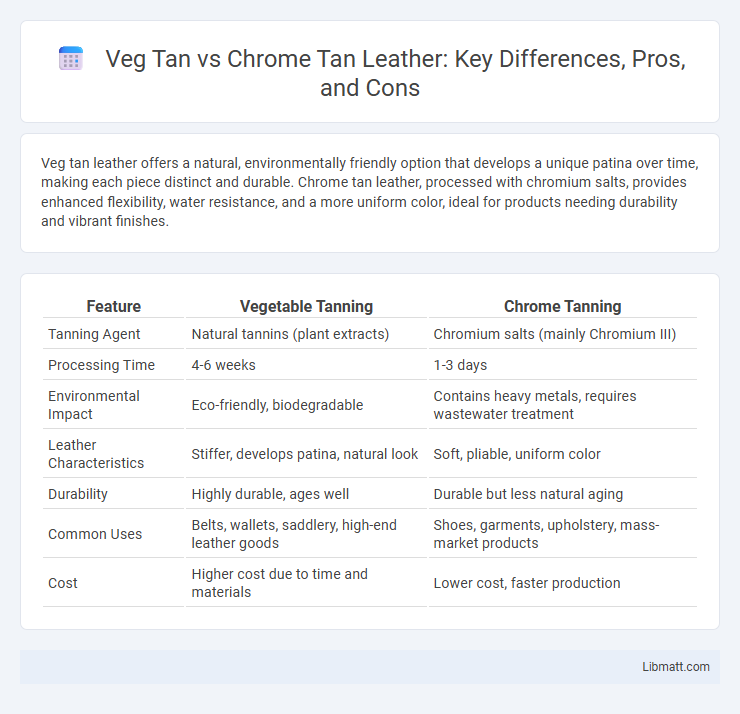Veg tan leather offers a natural, environmentally friendly option that develops a unique patina over time, making each piece distinct and durable. Chrome tan leather, processed with chromium salts, provides enhanced flexibility, water resistance, and a more uniform color, ideal for products needing durability and vibrant finishes.
Table of Comparison
| Feature | Vegetable Tanning | Chrome Tanning |
|---|---|---|
| Tanning Agent | Natural tannins (plant extracts) | Chromium salts (mainly Chromium III) |
| Processing Time | 4-6 weeks | 1-3 days |
| Environmental Impact | Eco-friendly, biodegradable | Contains heavy metals, requires wastewater treatment |
| Leather Characteristics | Stiffer, develops patina, natural look | Soft, pliable, uniform color |
| Durability | Highly durable, ages well | Durable but less natural aging |
| Common Uses | Belts, wallets, saddlery, high-end leather goods | Shoes, garments, upholstery, mass-market products |
| Cost | Higher cost due to time and materials | Lower cost, faster production |
Introduction to Leather Tanning Methods
Vegetable tanning uses natural tannins from plant sources like tree bark to create leather with a firm texture, rich color, and excellent durability, ideal for leather goods that age beautifully over time. Chrome tanning employs chromium salts, resulting in softer, more pliable leather with enhanced water resistance and faster production times, making it favored for mass-produced fashion and upholstery. Understanding these tanning methods helps you choose the right leather type based on durability, appearance, and intended use.
What is Vegetable Tanned Leather?
Vegetable tanned leather is crafted using natural tannins extracted from tree bark, leaves, and other plant materials, resulting in an eco-friendly and durable product. This type of leather develops a unique patina over time, enhancing its aesthetic and character with use. Your choice of vegetable tanned leather ensures sustainability and a classic, natural finish compared to the more chemically intensive chrome tanning process.
What is Chrome Tanned Leather?
Chrome tanned leather is produced using chromium salts, primarily chromium sulfate, which accelerates the tanning process, resulting in supple and water-resistant leather. This method enhances durability and maintains the leather's natural texture, making it ideal for products requiring flexibility and resistance to wear. Your choice between chrome and vegetable tanning depends on the desired finish, longevity, and environmental considerations of the leather item.
Key Differences Between Veg Tan and Chrome Tan
Vegetable tanning uses natural tannins found in tree bark and leaves, resulting in durable, eco-friendly leather with a rich, earthy aroma and a firm texture that develops a unique patina over time. Chrome tanning employs chromium salts, providing faster processing, increased water resistance, and softer, more pliable leather with a consistent color ideal for mass production. Understanding these key differences helps you choose leather that best suits your needs, whether it's sustainability and aging beauty or flexibility and color uniformity.
Durability and Longevity Comparison
Vegetable-tanned leather offers superior durability and develops a unique patina over time, enhancing its longevity with proper care, making it ideal for items like belts and wallets. Chrome-tanned leather is more flexible and water-resistant initially but tends to degrade faster under constant wear and exposure to heat or sunlight. Your choice depends on valuing long-term aging characteristics with veg tan or immediate softness and water resistance with chrome tan.
Environmental Impact of Each Tanning Process
Vegetable tanning utilizes natural tannins extracted from tree bark and plants, making it biodegradable and less harmful to the environment compared to chrome tanning, which relies on chromium salts known for their toxic waste and water pollution risks. Chrome-tanned leather often involves heavy metal contamination that can persist in soil and waterways, posing long-term environmental hazards. Choosing vegetable-tanned leather supports more sustainable practices by reducing your ecological footprint through lower chemical use and better biodegradability.
Aesthetic Qualities: Color, Texture, and Aging
Vegetable-tanned leather offers rich, warm hues that deepen with age, developing a natural patina and unique texture over time, while chrome-tanned leather typically maintains consistent color and softness without significant change. The texture of veg tan is firmer and more rigid initially, becoming supple yet retaining character as it wears, whereas chrome tan provides a smoother, more uniform surface from the start. Your choice depends on whether you prioritize the evolving aesthetic appeal and organic feel of vegetable tanning or the stable, vibrant finish and pliability of chrome tanning.
Common Uses for Veg Tanned vs Chrome Tanned Leather
Vegetable-tanned leather is commonly used for high-quality leather goods such as belts, wallets, saddles, and watch straps due to its durability, natural finish, and ability to develop a rich patina over time. Chrome-tanned leather is preferred for mass-produced products like shoes, handbags, upholstery, and jackets because of its softness, flexibility, and resistance to water and heat. Your choice between veg tan and chrome tan depends on whether you need long-lasting, firm leather or softer, more pliable material for everyday items.
Cost Considerations and Accessibility
Vegetable-tanned leather generally costs more due to its labor-intensive, time-consuming process and reliance on natural tannins, making it less accessible in mass markets compared to chrome-tanned leather, which is produced faster and at a lower cost using chromium salts. Chrome tanning's efficiency and scalability lower its overall expense, increasing availability in a wide range of products and price points. Consumers seeking eco-friendly, durable leather often pay a premium for vegetable-tanned goods, while chrome-tanned leather offers budget-friendly options with quicker production cycles.
Choosing the Right Leather for Your Needs
Vegetable-tanned leather offers durability and develops a unique patina over time, making it ideal for high-quality, long-lasting leather goods such as wallets and belts. Chrome-tanned leather, processed using chromium salts, provides greater softness, flexibility, and resistance to water and stains, suitable for fashion items and upholstery. Selecting the right leather depends on the desired finish, longevity, and functional use, with vegetable tanning favored for traditional craftsmanship and chrome tanning preferred for cost-effectiveness and versatility.
Veg tan vs chrome tan Infographic

 libmatt.com
libmatt.com